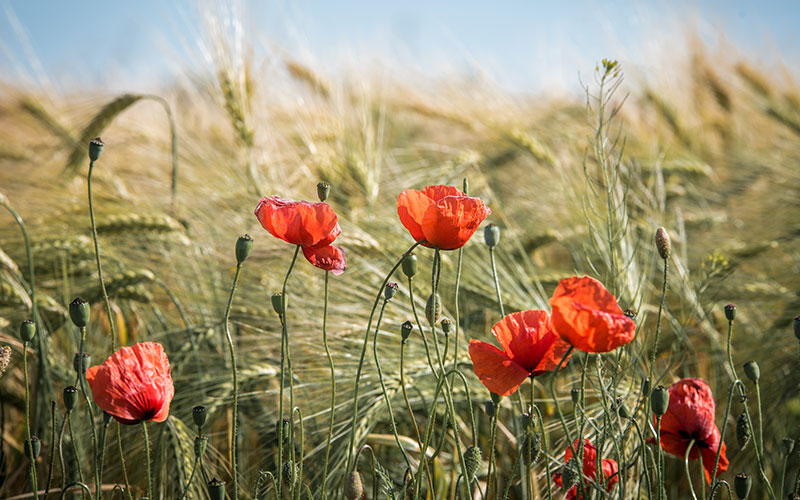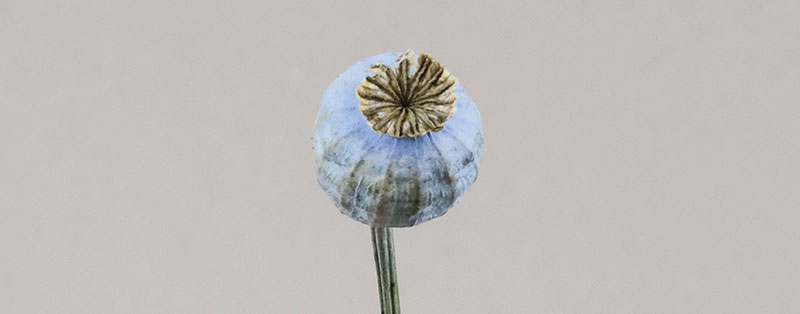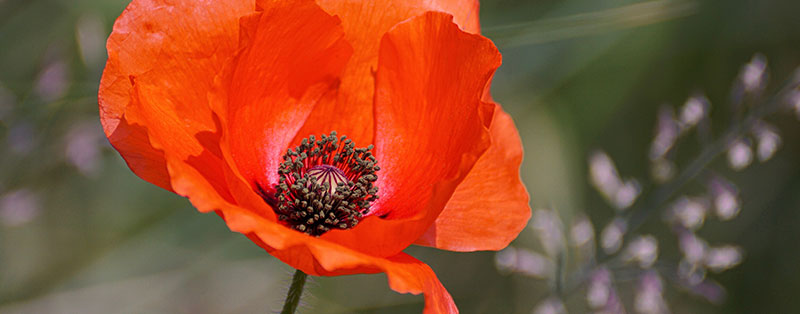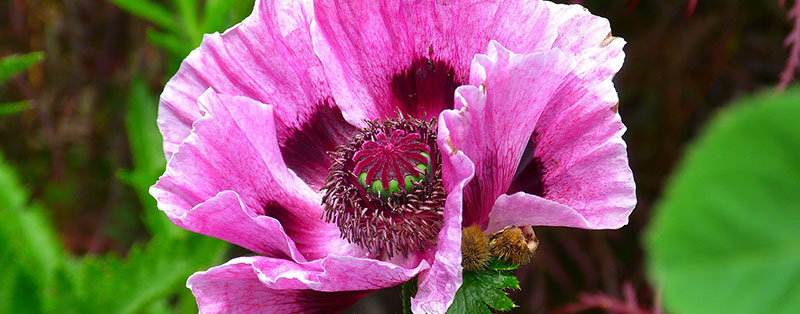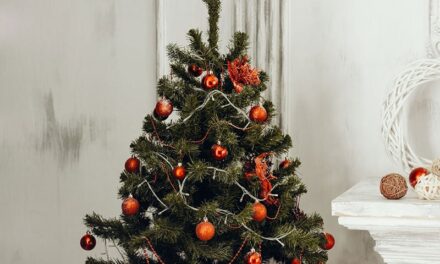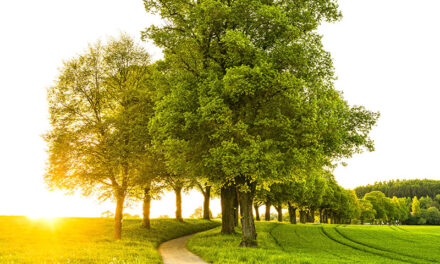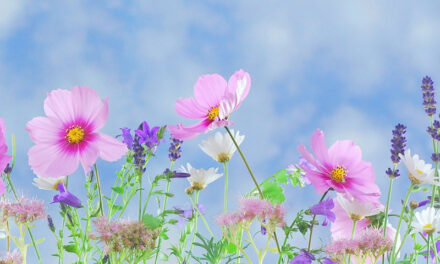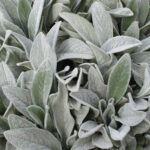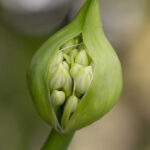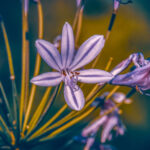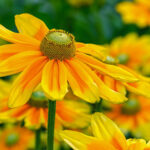The seeds of the poppy flower, for which it is also very well known, can be stored for up to 10 years and then still flower. Incredible, right?! The flower produces a lot of seeds, up to more than a 100 per flower, which are dispersed by the wind. They can therefore be encountered in all kinds of places in your garden, once they have bloomed in your area.
The poppy
Poppies or papaver are annual plants. Papaver is the scientific name of the poppy. They originated in the area around the Mediterranean Sea. Some of the species live as native plants in the Netherlands and Belgium which are the large poppy, the pale poppy, and the shaggy poppy.
Papaver Rhoeas is the large poppy, which you can often spot on roadsides and in newly constructed places. It is a flower with a leaf rosette, from which the flower stem emerges. The flower bud initially hangs from the stem, when it opens, the two sepals fall off and the stem stretches. The red petals unfold and in the center there is a recognisable, spherical fruit.
Poppy seed
The seed of the papaver is in the fruit of the center of the flower. It has small holes on the top, through which the seed can escape. This happens when, for example, it is windy or when someone or something touches the poppy flower. The seed comes out like grains of salt out of a salt shaker. They don’t all come out in one go, unless you shake out the flower fruit.
Harvesting poppy seeds
If you want to sow the seeds of the flower yourself, then you should pick the flower fruit. Do this when the fruit feels a bit drier and harder. Then cut them off the stem and lay them out to dry. When the fruit is completely dried, you can shake out the seeds. Open the fruit and shake them out in a jar or paper bag. Don’t be alarmed by the amount of seeds you harvest. This can amount to over a 100 small black spheres, each of which forms a new plant individually when planted.
Sowing poppies or planting poppies
Sowing the poppy is very easy. You scatter the seeds on a bare piece of ground that has been well turned up with a spud. The seed needs bare soil to germinate. Although, the plant makes few demands on the soil, the poppy also does well on non-fertile soil.
After you have scattered the small seeds, all you need to do is press down on the soil. The seeds are so small that they are already sufficiently covered. Then add a little water and voila! If you sow in March, April or May, you will still see the flowers grow the same year. If you choose to sow in autumn, the flowers will come the following year. The poppy flowers in the months of May, June and July.
Papaver flowers
Poppy flowers come in different shapes, sizes and colours. From the different types of colours there are red, orange, white, salmon, pink, lilac, dark purple and red purple.
Poppy poisonous?
Yes, unfortunately the poppy flowers and the plants are poisonous. All parts of the plant including the flower and the milky sap are highly poisonous. So humans and animals should be careful around them.
Read the article poisonous plants for dogs and cats if you want to know more about poisonous plants for dogs and cats.
Can you pick a poppy?
You are certainly not supposed to pick poppies and other wild flowers. A farmer or a grower has sown these flowers on his own land, possibly intended for sale. It is therefore a crime if you try to pick these flowers.
The seeds have also been sown in public space for a purpose. Often for the improvement of the soil or for the development of biodiversity. So plant your flower field and you can pick whatever you want. However, on the field you can enjoy them and their beauty for a longer period of time. An additional advantage is that the seed spreads again, in and around the place where the flower was, so you can enjoy your poppies for years to come.
Pruning the poppy flower
When you prune the poppy by the stem, right after flowering, there is a chance of a second bloom. This is dependent on the circumstances and the weather, so there is no guarantee.
Types of poppy flower
Like mentioned before, there are many different types of poppies. There are around 60 known species worldwide. In the Netherlands the rough poppy, long-headed poppy, common poppy, prickly poppy and the opium poppy are well known species that grow in the wild.
Red Papaver, Papaver Glaucum
A tulip poppy with a beautiful bright red color. The petal is somewhat wrinkled and gives a special accent to the border where it is planted. The height of this species is approximately 50 centimeters.
Large Common Poppy, Papaver Rhoeas
This is an annual flower and one of the best known species. It has a bright red color and you can see it in many places in the Netherlands, mainly in newly constructed areas. The latter is because they are true pioneer plants, they thrive on nutrient-poor soils.
Orange Poppy
Papaver Rupifragnum is an orange type that flowers in the months of April and May. The height of the flower is about 40 centimeters.
Long-headed poppy, Papaver Dubium
The name tells it all, a tall poppy with a pale red color. The height of the flower is 20 to 60 centimeters and grows in May, June, July and August. It is a good insect plant for flies and bumblebees.
White Poppy flower
A white, beautiful oriental type that flowers in May and June and reaches a height of approximately 70 centimeters. The Eastern Papaver Orientale ‘Perry’s White’ prefers a sunny spot. Weave the type through your border and you can turn them into interesting eye-catchers.
Pink Poppy flower
A pink type of poppy is the Oriental Papaver ‘Pink Perfection’. A real candystick pink variety that has a large size, between 60 and 80 centimetres. The flowering takes place in the months of May, June and July in a spot in the sun or in partial shade.
Purple Poppy, Papaver Somniferum
This species is called the opium poppy. The sowing period is from March to May, the flowering will then occur the same year. A poppy germinates quickly, the flowering happens in the months of May, June, July and August. It is a very striking purple coloured species.
Papaver Oriental, Eastern Poppy
A light pink or salmon coloured oriental poppy, which flowers in May and June. The height of this flower is approximately 75 centimeters. The Papaver Oriental ‘Helen Elisabeth’ is a beautiful variety to weave through the border. This poppy prefers a spot in full sunlight.
Poppy Nudicaule
Also known as the Iceland poppy, this variety blooms in different colours: white, yellow, orange and pink. The flowering time of the 40 centimeter high plant is in May and June.

